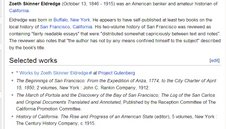Below: Indo on Zoeth S. Eldredge’s book: The March of Portola and the Discovery of the Bay of San Francisco
From John Vonderlin
Email John ([email protected])
|
Hi June,
The book by Zoeth S. Eldredge, “The March of Portola and the Discovery of the Bay of San Francisco,” can be read for free at Archive.org. If you use “Portola” in the Search box you will find Mr. Eldredge’s book, and two other books about the 1769 Portola Expedition. One is Miguel Costanso’s diary and the other Vicente Vila’s.
Here’s the excerpt from when they were on the Coastside.
On the 20th they were at Punta de Ano Nuevo,
and camped at the entrance of the canon of Waddell creek. They recognized Point Ano Nuevo from the description given by Cabrera Bueno, and Crespi estimated that it was one league distant from the camp. With good water and fuel, the command rested here the 21st and 22d. Both Portola and Rivera were now added to the sick list. Meat and vegetables had given out and the rations were reduced to five tortillas of bran and flour per day. Crespi named the camp San Luis Beltran, while the soldiers called it La Canada de Salud. On the 23d, they again moved forward, passing Punta de Ano Nuevo and, traveling two leagues, camped probably on Gazos creek, where was a large Indian rancheria, whose inhabitants received them kindly. This camp, which was about opposite Pigeon Point, they named Casa Grande, also San Juan Nepomuceno[27]. The next jornada was a long one of four leagues, and their camp was on San Gregoria creek. It began to rain and the command was prostrated by an epidemic of diarrhoea which spared no one. They now thought they saw their end, but the contrary appeared to be the case. The diarrhoea seemed to relieve the scurvy, and the swollen limbs of the sufferers began to be less painful. They named the camp Vane de los Soldados de los Cursos, and Crespi applied the name of Santo Domingo to it. Unable to travel on the 25th and 26th, but resuming the march October 27th, they pressed forward. The next stop was Purisima creek, two short leagues distant, but the way was rough, and the pioneers had to make roads across three arroyos where the descents were steep and difficult for the transportation of the invalids. On the bank of the stream was an Indian rancheria, apparently deserted. The Spaniards took possession of the huts, but soon came running forth with cries of “las pulgas! las pulgas![28]” They preferred to camp in the open. The soldiers called the camp Rancheria de las Pulgas, while Crespi named it San Ibon. On the 28th they camped on Pilarcitos creek, site of Spanish town or Half Moon Bay. They named the camp El Llano de los Ansares – The Plain of the Wild Geese – and Crespi called it San Simon y San Judas. Every man in the command was ill; the medicines were nearly gone and the supply of food very short. They contemplated killing some of the mules. That night it rained heavily and Portola, who was very ill, decided to rest on the 29th. On Monday, October 30th, they moved forward. Half Moon Bay and Pillar Point were noted but no names given. Several deep arroyos were crossed, some of which required the building of bridges to get the animals over. They proceeded up the shore until a barrier of rock confronted them and disputed the passage. Here in a rincon (corner) formed by the sierra and. sheltered from the north wind they camped while Ortega and his men were sent out to find a passage over the Montara mountains. A little stream furnished them with water and they named the camp El Rincon de las Almejas, on account of the mussels and other shell fish they found on the rocks. Crespi calls it La Punta del Angel Custodia. The site of the camp is about a mile north of the Montara fog signal. By noon of the next day, October 31st, the pioneers had prepared a passage over the bold promontory of Point San Pedro, and at ten o’clock in the morning the company set out on the trail of the exploradores and made their painful way to the summit. Here a wondrous sight met their eyes and quickened their flagging spirits. Before them, bright and beautiful, was spread a great ensenada, its waters dancing in the sunlight. Far to the northwest a point reached out into the sea, rising abruptly before them, high above the ocean. Further to the left, west-northwest, were seen six or seven white Farallones and finally along the shore northward they discerned the white cliffs and what appeared to be the mouth of an inlet. There could be not mistake. The distant point was the Punta de los Reyes and before them lay the Bahia o Puerto de San Francisco. The saint had been good to them and with joy in their hearts they made the steep and difficult descent and camped in the San Pedro valley[29] at the foot of the Montara mountains. Some of the company thought they had left the Port of Monterey behind The next day, Thursday, November 2nd, being All Souls day, after mass On Saturday, November 4th, being the day of San Carlos Borromeo, in |


